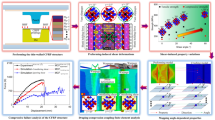Abstract
Advanced thermoplastic prepreg composite materials stand out with regard to their ability to allow complex designs with high specific strength and stiffness. This makes them an excellent choice for lightweight automotive components to reduce mass and increase fuel efficiency, while maintaining the functionality of traditional thermosetting prepreg (and mechanical characteristics) and with a production cycle time and recyclability suited to mass production manufacturing. Currently, the aerospace and automotive sectors struggle to carry out accurate Finite Elements (FE) component analyses and in some cases are unable to validate the obtained results. In this study, structural Finite Elements Analysis (FEA) has been done on a thermoplastic fiber reinforced component designed and manufactured through an integrated injection molding process, which consists in thermoforming the prepreg laminate and overmolding the other parts. This process is usually referred to as hybrid molding, and has the provision to reinforce the zones subjected to additional stresses with thermoformed themoplastic prepreg as required and overmolded with a shortfiber thermoplastic resin in single process. This paper aims to establish an accurate predictive model on a rational basis and an innovative methodology for the structural analysis of thermoplastic composite components by comparison with the experimental tests results.











Similar content being viewed by others
References
Carello, M., Airale, A.G., Scattina, A.: Carbon fiber monocoque for a hydrogen prototype for low consumption challenge. Mat.-wiss. Werkstofftech. 42(5), 386–392 (2011)
Carello, M., Airale, A.G., Messana, A.: IDRApegasus: a carbon fiber monocoque vehicle prototype. Mat. -wiss. Werkstofftech. 45(5), 397–405 (2014)
Haibin, N., Uday, V., Gregg, M.J., George, H.: Design, manufacture and analysis of a thermoplastic composite frame structure for mass transit. Compos. Struct., 105–116 (2007)
d'Hooghe, E.L., Edwards, C.M.: Thermoplastic Composite Technology; Tougher Than You Think, 12th ed, pp. 1717–1885. WILEY, Weinheim (2000)
Carello, M., Airale, A.G.: Composite suspension arm optimization for the City vehicle XAM 2.0. Design and Computation of Modern Engineering Materials. 54, 257–272 (2014)
Ribeiro, M.L., Tita, V., Vandepitte, D.: A new damage model for composite laminates. Compos. Struct., 105–116 (2011)
Kazemi, M., Verchery, G.: Design of composite laminated plates for maximum buckling load with stiffness and elastic modulus constraints. Compos. Struct., 105–116 (2016)
Rouse, M., Jegley, D.C., McGowan, D.M., Bush, H.G., Waters, W.A.: Utilization of the Building-Block Approach in Structural Mechanics Research. NASA, 105–116 (2005)
Tenney, D.R., Davis, J.G. Jr, Pipes, R.B., Johnston, N.: NASA composite materials development: lessons learned and future challenges. NATO Research and Technology Agency (RTA) (2009)
Polymer Matrix Composite guidelines for charecterisation of composite structural materials. Department of Defense handbook, Composite material handbook. 12th ed. USA: MIL-HDBK-17-1F (2002)
Tri-mack. Hybrid Molding. Available: http://www.trimack.com/hybrid-molding (2016)
Zoellner, O.J., Evans, J.A.: Plastic-Metal Hybrid: a New Development in the Injection Molding Technology. In Proceedings of SPE Annual Technical Conference (ANTEC), San Francisco (2002)
Vermeeren, C.A.J.R.: An historic overview of the development of fibre metal laminates. Appl. Compos. Mater. 10(4–5), 189–205 (2003)
Minett, S., Fenwick, K.A.: A steel-rubber laminate that can quieten cars & other machines. Noise & Vibration Worldwide. 30(2), 12–13 (1999)
Ginger Gardiner. Hybrid Molding. Available: http://www.compositesworld.com/articles/overmolding-expands-peeks-range-in-composites (2015)
Baldan, A.: Review: Adhesively-bonded joints in metallic alloys, polymers and composite materials: Mechanical and environmental durability performance. J. Mater. Sci. 39, 4729–4797 (2004)
Compositi ad alta velocità, Proplast. Available: http://www.plastix.it/compositi-ad-alta-velocita/ (2016)
TEPEX® DYNALITE. Maximum strength at minimum weight. Available: http://bond-laminates.com/en/materials/tepexR-product-families/tepexR-dynalite/ (2015)
Fibermod™ GD301FE. Fibermod. Available: http://www.borealisgroup.com/en/polyolefins/products/Fibermod/Fibermod-GD301FE/ (2015)
Baker, D.J.: Mechanical property charecterisation and impact resistance of selected graphite/peek composite materials. NASA Aerostructures directorate U.S.Army research and technology activity (AVSeOM). USA: VA. 23665-5225, 105–116 (1991)
CRASURV formulation Composite and Fabric Materials, Hyperworks: Radioss Reference Guide, Starter Input, /MAT/LAW25 (COMPSH) (2016)
Paris, F.: A study of failure criteria of fibrous composite materials. George Washington university joint institute for the advancement of flight sciences langley research center (NASA). Hampton, Virginia (2001)
Interfaces and Kinematic Constraints. Hyperworks: Radioss Reference Guide, (2016)
Acknowledgements
The authors would like to thank: Altair Engineering Italy for the Software support and BeonD S.r.l, Italy for sharing their knowledge in testing and modelling thermoplastic composites.
Author information
Authors and Affiliations
Corresponding author
Ethics declarations
Funding Source
This research is funded by the IEHV (Innovative Electric and Hybrid Vehicles) Research Group of Politecnico di Torino - Mechanical and Aerospace Engineering Department and Proplast with their own resources.
Rights and permissions
About this article
Cite this article
Carello, M., Amirth, N., Airale, A.G. et al. Building Block Approach’ for Structural Analysis of Thermoplastic Composite Components for Automotive Applications. Appl Compos Mater 24, 1309–1320 (2017). https://doi.org/10.1007/s10443-017-9592-x
Received:
Accepted:
Published:
Issue Date:
DOI: https://doi.org/10.1007/s10443-017-9592-x




